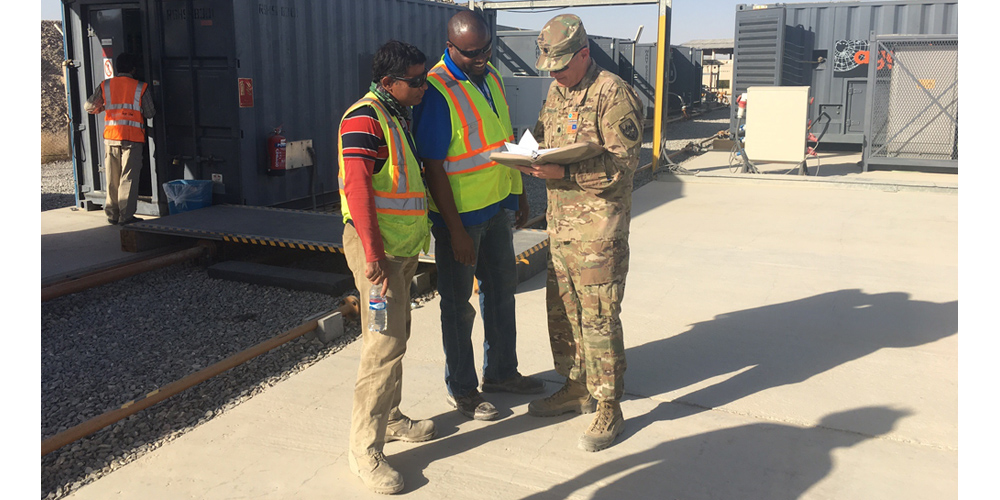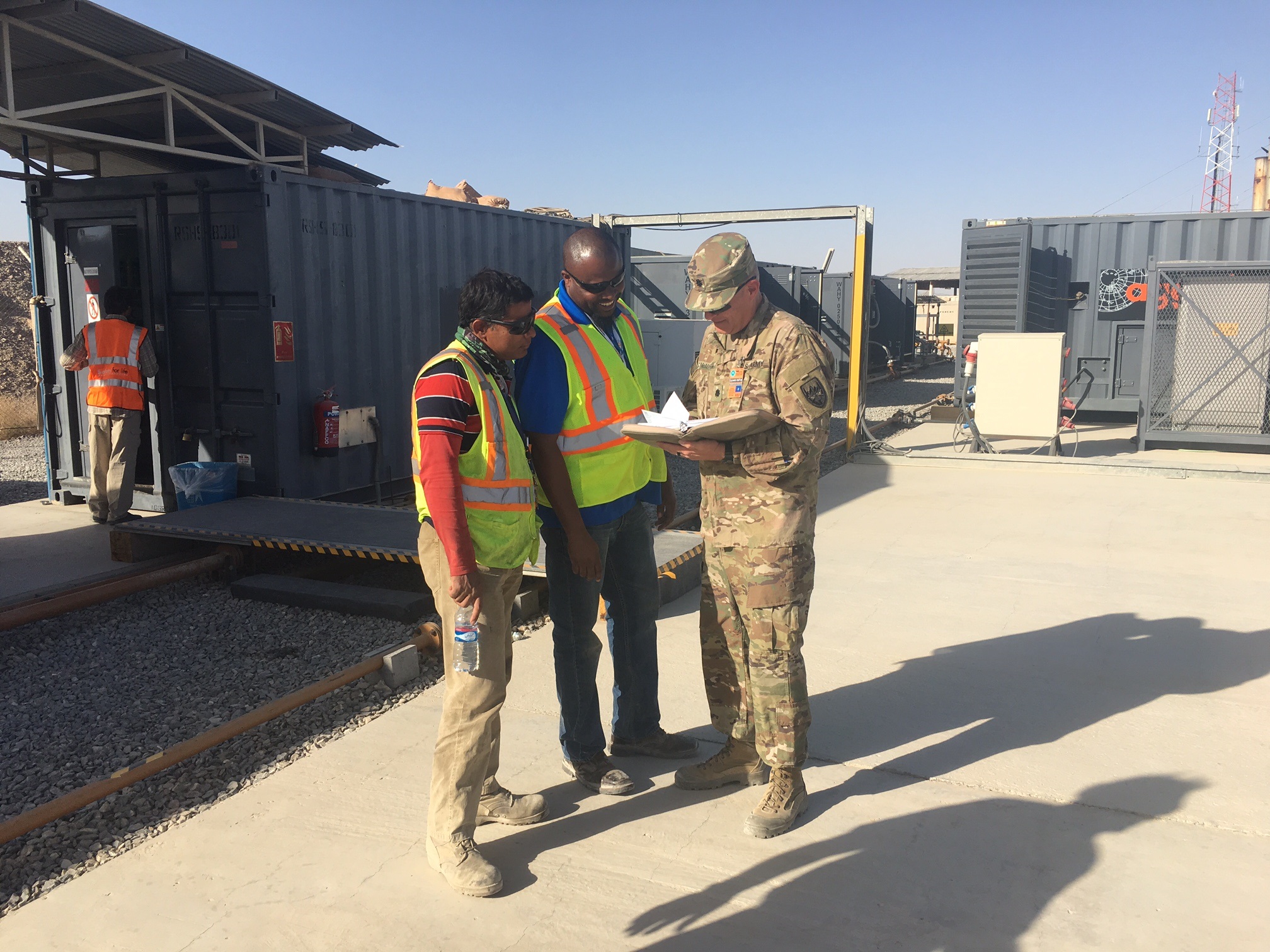
Being a good steward of taxpayer dollars means thinking and acting decisively. That’s just what CCAS and ECC-A did—examining and consolidating the contracts under its purview to make it easier and cheaper for to operational commanders to obtain services for their troops.
by Mr. Gordon Jones
Sustaining joint forces to train, advise and assist the Afghan National Police and Afghan National Army requires the efficient use of contract resources. Within 30 days of standing up the Contingency Contract Administration Service (CCAS) team’s mission in Afghanistan, senior staff elements of United Stated Forces – Afghanistan (USFOR-A) approached the Expeditionary Contracting Command – Afghanistan (ECC-A) for assistance in evaluating a recommendation to move to a single service provider in Southern Afghanistan, in support of USFOR-A’s contract optimization efforts. Maj. Gen. Jeffrey L. Bannister, deputy commanding general of USFOR-A, directed a comprehensive optimization of all contracting actions to eliminate duplicate services, improve operational efficiency, reduce costs, reduce contractors in the battlespace and improve government oversight. Termed “Operation Firm Investment,” one phase of the optimization initiative looked at Kandahar Air Field (KAF), where two major service providers were providing essentially the same basic life support services.
A COMPLEX EVALUATION
To provide this assistance, Col. Carol M. Tschida, ECC-A commander, tasked the senior CCAS staff to perform best value analysis that focused on operational efficiencies aligned to organization structures. The desired result of that analysis was to provide cost reductions and benefits to the U.S. government without impacting the readiness of the warfighter.
“This analysis was one of the most complex evaluations I have been involved with because of the fundamental differences between the two primary service providers involved at KAF,” Tschida said. On one hand is the Logistics Civil Augmentation Program (LOGCAP), which uses a cost-plus-fixed-fee contract that provides matrixed services over more than 80 performance work statements (PWS). The PWS are aligned to functions, such as facilities maintenance, roads and grounds and power generation, so any individual requirement may involve multiple PWS. Three LOGCAP contracts are multiple-award task order contracts. These three contracts require compliance with the Federal Acquisition Regulation (FAR), Army regulations and technical compliance regulations.
The other service provider is the NATO Support and Procurement Agency (NSPA), which uses firm fixed-price contracts that are geared toward meeting a particular requirement or group of requirements in a holistic manner. These NSPA contracts are exempt from compliance with U.S. contract law or the FAR, and the contract compliance and oversight requirements are not as stringent or structured as those under LOGCAP. This disparity in contract methodology added a layer of complexity to the analysis and comparison that was unlike anything one normally experiences during their contract career.
After several months of an intense deep-dive analysis, Bannister decided to move toward LOGCAP as the primary service provider in Southern Afghanistan, citing performance synergies obtained across the hub-and-spoke performance locations in Southern Afghanistan, the increased contract performance surveillance networks available through DOD and the lower cost to the government. This decision reinforced migration toward a single service provider—LOGCAP—which also is the U.S. Army’s logistics program of record to support contingencies.

POINTING OUT THE DETAILS
ECC-A Property Book Officer Michael L. Mangum, left, and Maj. Reuben T. Joseph, chief of the Regional Contracting Office – South, discuss the operations of the main reverse osmosis water purification unit at Kandahar Air Field, Afghanistan. Joseph was the KAF transition coordinator for the ECC-A Regional Contracting Office – South, ensuring that services were provided without interruption during the transition from NATO contracts to LOGCAP. (All images courtesy of the author)
The decision encompassed locations across Southern Afghanistan, including KAF and Forward Operating Bases at Shorab and Dwyer, and involved a phased approach where LOGCAP would assume functions over time as the existing NSPA contracts reached the end of their periods of performance in order to avoid early termination penalties. It also resulted in a single “belly-button,” or responsible party, for most services, to ease the burden on the operational commanders to obtain faster and more cost-effective services for their troops. “This decision was a win-win for USFOR-A, the Resolute Support commanders and the taxpayers,” Tschida said, “as movement to LOGCAP is projected to result in savings of over $30 million per year.”
LOGCAP TRANSITION
Following the USFOR-A decision to move to LOGCAP, the overall involvement of the CCAS team was just beginning. Because of the timing of the USFOR-A decision, less than 45 days remained for the initial transition to occur between LOGCAP and NSPA. In a contingency environment, the transition had to be seamless: a lapse in service could have a negative impact on ongoing operations.
To assist in the transition, Tschida immediately increased the number of quality assurance specialists (QAS) and dispatched a property book officer/property administrator to coordinate the inventory and conversion of NATO-furnished property to government-furnished property accountable under the LOGCAP contract. This in itself was a challenge because transferring NATO property laterally to a U.S. contract is a new area, requiring innovative processes and solutions.
Next, CCAS QAS conducted training for all of the contracting officer’s representatives (CORs), including providing assistance with generating and implementing detailed contract performance surveillance checklists and schedules to ensure contractor compliance with the terms and conditions set forth in the contract. This, too, proved challenging: Under NSPA, all oversight was provided by the NSPA Program Office, so there were no U.S. CORs on ground and familiar with the specific tasks being performed. This meant that CORs had to be nominated, trained, approved, appointed and added to the DOD COR Tracking Tool, all in a matter of days.
Maj. Reuben Joseph was the KAF transition coordinator for the ECC-A Regional Contracting Office – South. “The transition involved countless issues, each having the capability to result in an unacceptable gap in service,” Joseph said. “The transition had a very short suspense, made more complex as it was simultaneously occurring at three different locations. Obviously, you tend to concentrate on the life, health and safety issues—power, water and food—but each of the secondary functions had to be checked and cross-checked to ensure that uninterrupted continuation of services was maintained. Because of the hard work on the part of LOGCAP and their prime contractor, the transition was nearly flawless and executed without a gap in any of the services.”

EASING THE TRANSITION
Analyzing which contract vehicle was best to support dining facilities like this one and other services at Kandahar Air Field was complicated by differing contract terms and structures, and implementing the change to the better option was made difficult by the lack of appropriate contract support personnel in theater. (All images courtesy of the author)
CONCLUSION
When Bannister first approached ECC-A to assist in this analysis, his guidance was clear, “Nothing is off the table. Consider all strategic, operational, and fiscal variables; the process and end state is to measure twice, cut once.” Working from this vision, the ECC-A team joined forces with the USFOR-A Operational Contract Support and J4 cells to form a cohesive unit to deliver a viable recommendation to the leadership.
“Despite the complexity of the transition, the end result was a resounding success,” said Tschida, “a team effort from start to finish.” The success of this effort will serve as a springboard for Phase II of the transition, she said, scheduled to occur on Jan. 1, 2017, when the additional services of laundry, janitorial, chemical latrines and the Giant Voice system move from NSPA to LOGCAP. “We’ll be ready,” said Tschida. “We have a great team that is committed to the mission and [has] never lost sight that the ultimate objective was to provide uninterrupted service to the warfighter and all supporting personnel. The decision to expand the LOGCAP operations in Southern Afghanistan will result in increased contract obligations of approximately $750 million over the next five years for ACC.”
With ECC-A, it was, is and always will be, “One Team, One Fight.” We remain engaged, capable and committed.
For more information, contact the author at gordon.jones.civ@mail.mil.
GORDON JONES is coordinator for CCAS, ECC-A. He holds a MBA, a B.S. in physics and biology and a B.A. in management from the University of Alabama at Huntsville. He is Level III certified in contracting and Level II certified in property management, and is a member of the Army Acquisition Corps.
This article will be published in the January – March 2017 issue of Army AL&T Magazine.
Subscribe to Army AL&T News, the premier online news source for the Acquisition, Logistics, and Technology (AL&T) Workforce.







